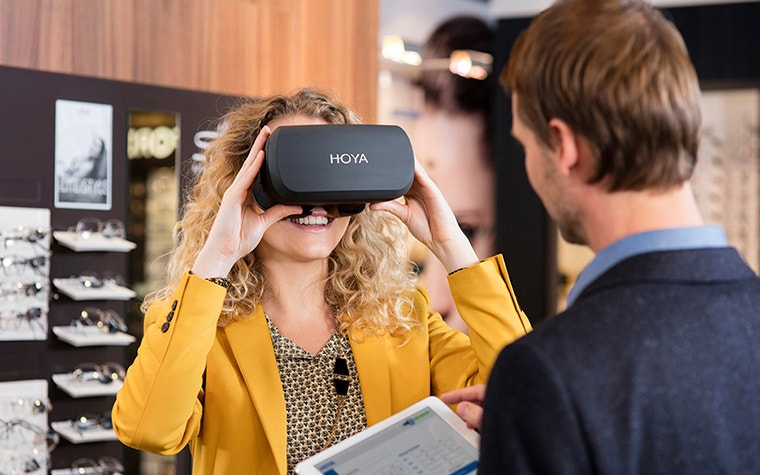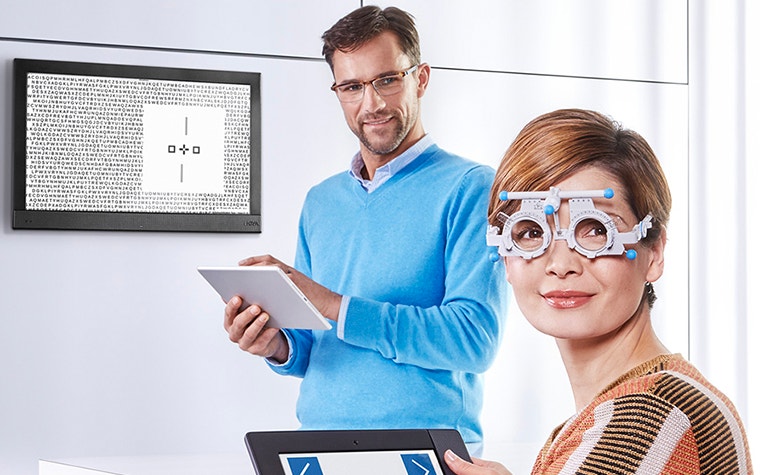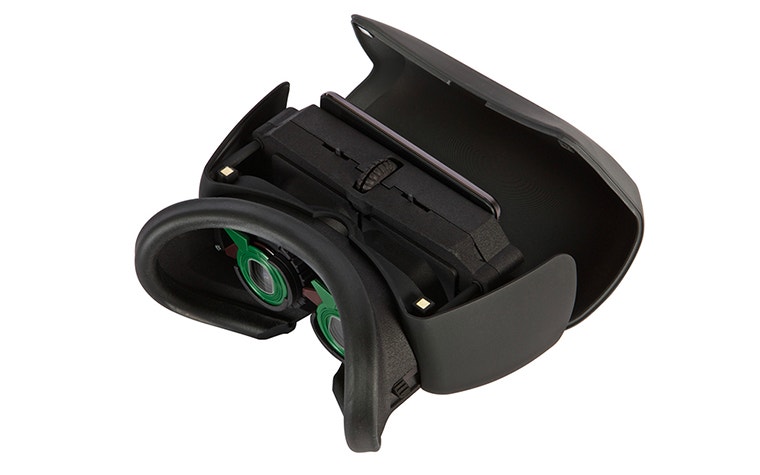CASE STUDY
HOYA’s Vision Simulator and EyeGenius: 3D-Printed Eyecare Devices

What was your last eye test like? Materialise’s partnership with HOYA is bringing in a virtual reality simulator that lets you truly experience lenses before buying them, while a high-precision eye examination system offers opticians a choice of 60 vision tests.
The era of Snellen and LogMAR charts — the familiar light boxes with rows of progressively smaller characters — may be coming to an end. Created by Materialise, in collaboration with HOYA Vision Care Company, a key player in the global market for ophthalmic lenses, these new devices upgrade eye examinations by opticians and enhance the end consumer’s shop experience.
HOYA EyeGenius is a high-precision measurement system that calculates the ideal prismatic prescription for the correction of fixation disparity. On top of that, with HOYA EyeGenius, the optician has 60 vision tests at hand to carry out a complete eye examination, including refraction, binocular vision screening, and visual function screening.
HOYA’s Vision Simulator enables the end-user to experience the vision they will have with their new HOYA lenses in a ‘real-life’ 3D visual representation based on their actual prescription. Simply said: they can try out their new lenses before buying them, right in the store. Both devices use tablets, TV screens, and smartphones for visual input.


From design to manufacturing
Preparing large batches of innovative products like these for additive manufacturing involves tackling design and engineering facets as well as a certified, repeatable production process. For an innovation-driven company like HOYA, it is essential to keep their systems on top of market developments. So how do you create a virtual reality device, containing an interior slot for a smartphone, now that smartphones are constantly evolving? How do you deliver a product that can be upgraded for new design iterations while maintaining impressive time-to-market?


If you want to turn a smartphone into a virtual reality simulator, it is key to provide an intelligent housing design. “Even though a smartphone provides high-quality images, the virtual reality experience is delivered by the ‘goggle-style’ housing in combination with high-tech optical lenses,” says Félix España, Manager of New Media at HOYA Vision Care Europe. “It has to fully envelop the wearer’s vision and peripheral vision, allowing the wearer to see nothing but the visuals on the screen.”
With this highly accurate device concept in mind, HOYA turned to Materialise. España explains: “Additive manufacturing provides a tremendous amount of design flexibility and allows us to enter production more quickly. This enables us to react swiftly to changing market demands.”
A vision to co-create: design and integrated features
Based on a co-creation session with experts from Eyedak and HOYA, engineers at Materialise began developing a design for the HOYA Vision Simulator that made the most out of 3D printing. Using the available freedom of design to maximize functionality, engineers integrated the requested mechanical functions directly into the design, while taking into consideration aesthetics and an ergonomic shape.


For the HOYA Vision Simulator, engineers started by creating a housing that would fit perfectly around the face and eyes. The housing contains an interior slot for the smartphone. This slot can be customized based on the type of smartphone to guarantee a perfect fit. Materialise also integrated the required option to insert trial lenses to provide the best visual performance for every prescription. An adjustment wheel, also integrated into the design, allows the optician to change the monocular pupil distance to ensure the best fit for all users.
For the HOYA EyeGenius, Materialise engineers worked with HOYA to design a mount and stand for a tablet, as well as a housing frame for a TV screen. By choosing to manufacture in laser sintering, the advantages of 3D printing technology were used to the fullest. The designers introduced an integrated swivel hinge to change the viewing angles and an integrated docking station with a magnetic lock.
Eyes on the future: next steps
The housings of the new HOYA EyeGenius and the exterior cover for the Vision Simulator system are vacuum cast, based on master copies made with stereolithography. The interiors of the Vision Simulator will continue to be produced in laser sintering. “Combining 3D-printed interior parts with vacuum casting housing has allowed us a remarkably fast time-to-market. And it keeps the costs of future design upgrades limited,” says Alireza Parandian at Materialise. For a device that uses smartphones and tablets in a fast-moving world of technology, this is crucial. If the latest iPhone is too slim for the current slot in the HOYA Vision Simulator, a new production run can be set up within five working days.
So when you next visit your optician, you might experience vision in a 3D-printed virtual reality environment — while getting your vision checked with the most advanced and accurate technology.
All images courtesy of HOYA Vision Care Company
Share on:
This case study in a few words
HOYA Vision Care Company
Eyewear
Vacuum casting
Stereolithography
Selective laser sintering
Maximum functionality
